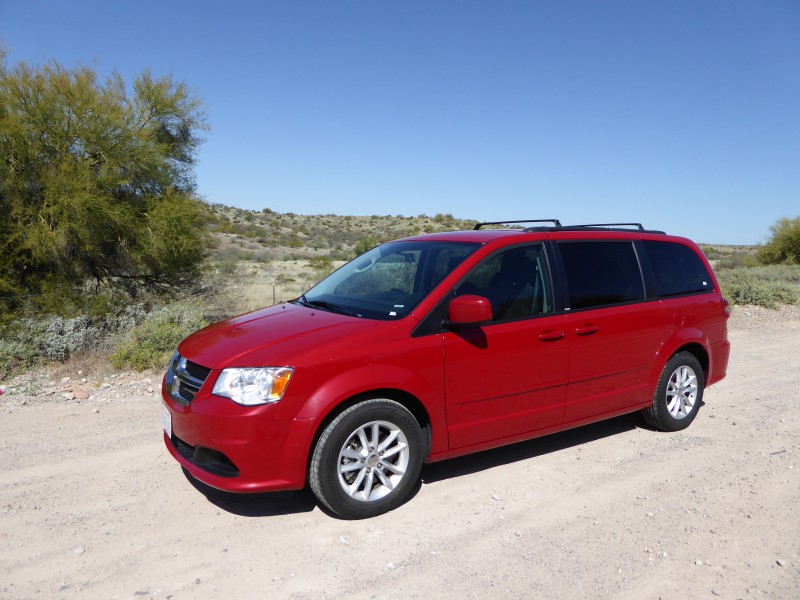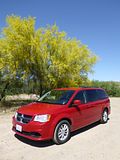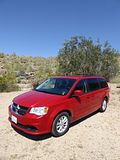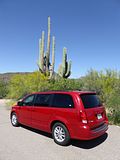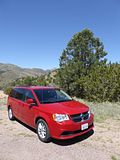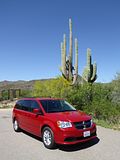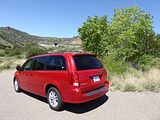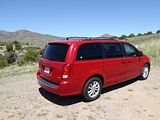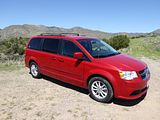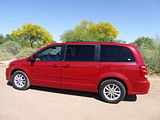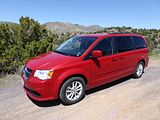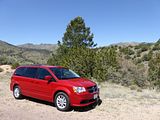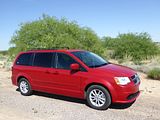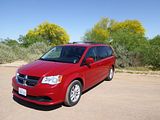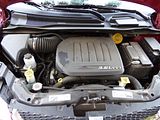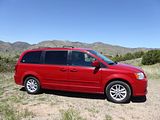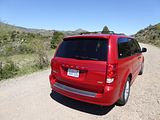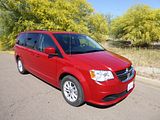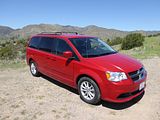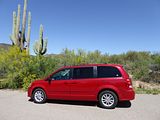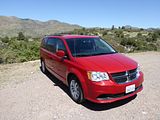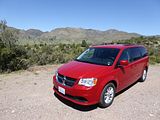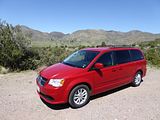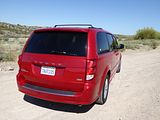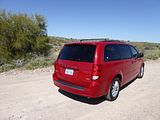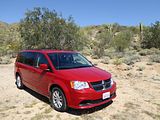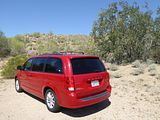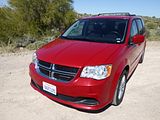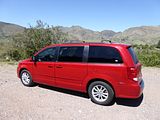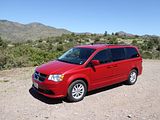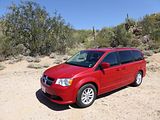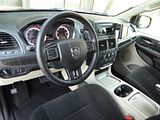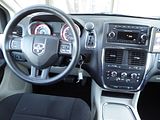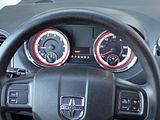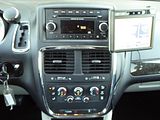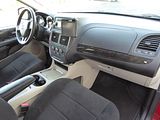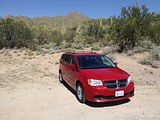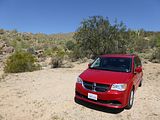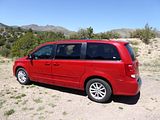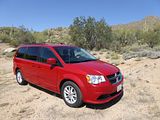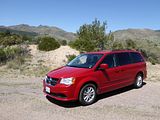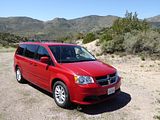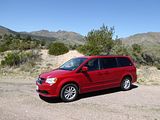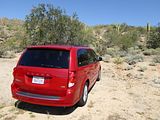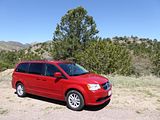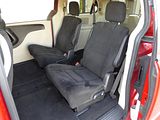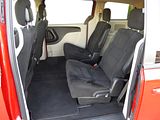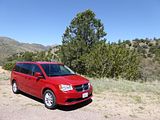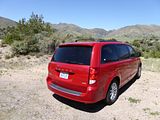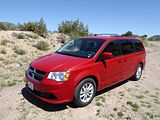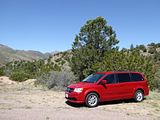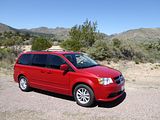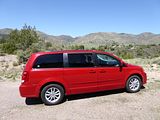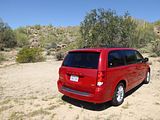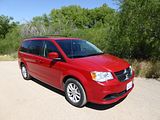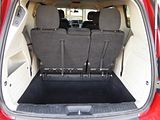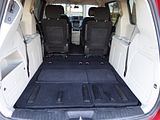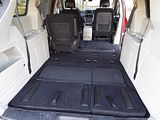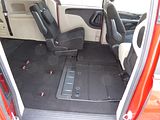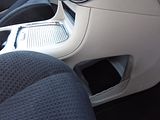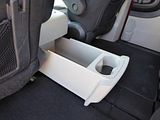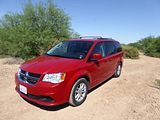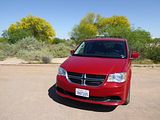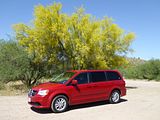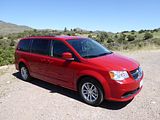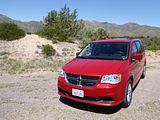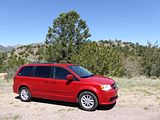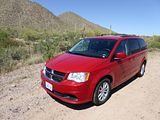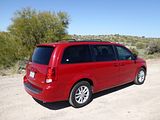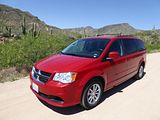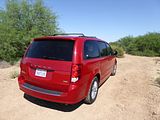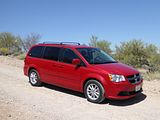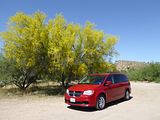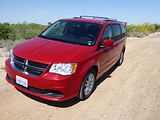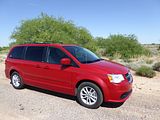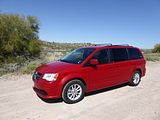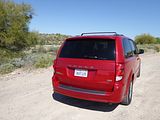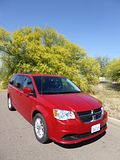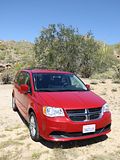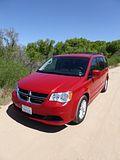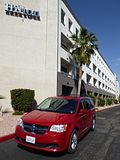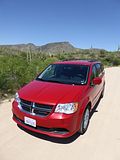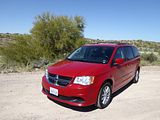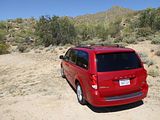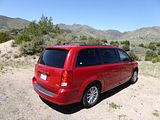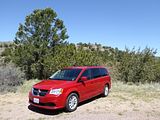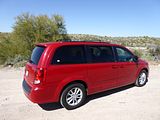
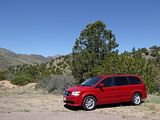

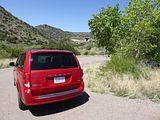
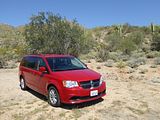
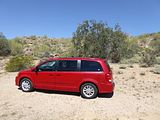
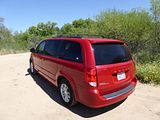
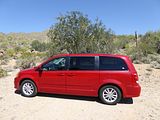
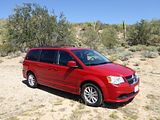
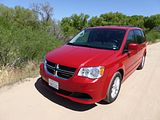
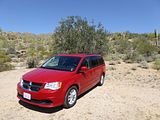
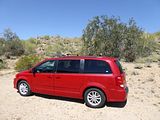
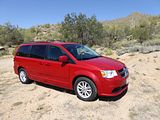

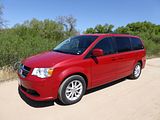
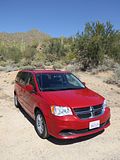
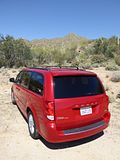
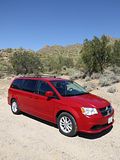
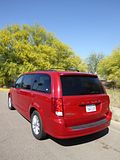
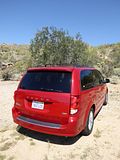
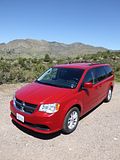

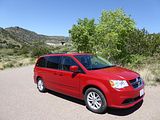
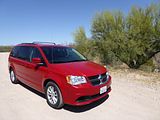
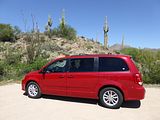
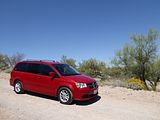
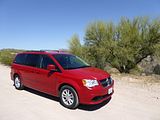
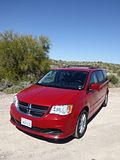
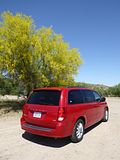

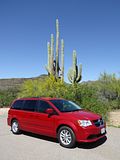
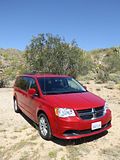
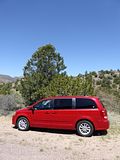




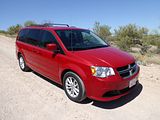
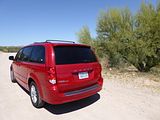
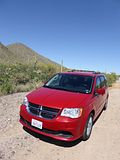
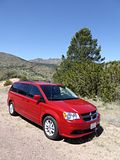
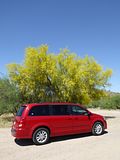
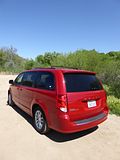
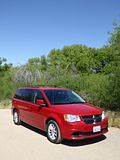
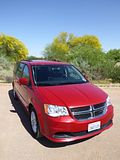

The Grand Caravan, and closely related Chrysler Town & Country, are currently coming towards the end of their fifth generation, with a successor likely to be unveiled during 2016. The latest body style, visually closely related to the models that have gone before was first shown at the 2007 North American International Auto Show at Detroit, going on sale later that year as a 2008 model year vehicle. Unlike previous generations, there only was a long wheelbase model, Chrysler choosing to offer buyers the crossover-like Dodge Journey as an alternative, citing the fact that buyers who really wanted a Minivan wanted the extra space of the larger vehicle, even though over 50% of the sales of the previous generation model in markets such as Canada had been for the short wheelbase model. Many of the mechanical components were initially carried over, including the old engines, though a six speed gearbox was a new feature. Of more interest were the “StowN’ Go” seats and upgrades to the standard equipment levels including a new entertainment system, second and third row video screens on some models and additional safety features. The new model was sold as the Dodge Grand Caravan and Chrysler Town & Country. In 2008, a lightly modified version appeared with VW badges on it, called the VW Routan, featuring the 3.8 litre V6 engine. Its sales were dismal, with fewer than 10,000 having buyers in the first two years it was offered and the model was deleted in 2012, though cars lingered in the showrooms for a long time after that. European models, primarily sold with 2.8 litre VM Motori diesel engines fared little better, as the vehicle was simply too large for European tastes. Putting Lancia badges on it for markets such as the UK, where it was rebranded from Chrysler to Lancia made no difference, but in America, sales were strong. Minor modifications were made every year, as is the US way and then for the 2011 model year a significant mid-life refresh introduced not just new badging and cosmetic changes but the replacement of all the old engines with the 3.6 litre PentaStar V6 unit, and changes to the suspension and steering as well as a lowered ride height, alterations which the press reckoned made significant improvements to the handling. The interior – historically a week point on Chrysler Group products – also received changes with new softer touch surfaces, more sound insulation and new equipment features. There have been minor changes since then, but nothing of significance, so although the test car that I received was a 2013 model year vehicle, it was still likely to be representative of the model you could go into your local Dodge showroom and buy brand new in 2015. Question is, if you are in the market place for a Minivan, should you going there, or are you better off at one of the Japanese or Korean brands who sell the most direct rivals to the Grand Caravan.
Standard engine in all North American market Grand Caravan models now is the 3.6 litre PentaStar V6 unit, generating 283 bhp, coupled to a six speed automatic transmission. That’s quite a few more horses more than you will find in any of the competition and is enough to make this rather sizeable vehicle feel decently brisk. There’s quite a pleasing throaty roar to the engine when you press the accelerator and the overall impression is that this is quite a lusty unit, well capable of moving the Grand Caravan. The transmission is super smooth, too. It does have a manual mode, if you push the dash mounted lever to one side from its normal D position. or if you use the switches on the reverse side of the steering wheel hub, which fall neatly to hand. Going up some moderate inclines on Route 87 out of Phoenix, I could tell that the Dodge did drop a gear, but otherwise it maintained its momentum impressively well, where plenty of others lose speed. The price to pay is at the pumps, however. I drove the test car 166 miles and it burned through 8.2 gallons of regular, which computes to 20.25mpg US, or 24.18 mpg Imperial. Probably what I should have expected, to be honest, as there is a lot of vehicle to move.
What I was not expecting, perhaps remembering the last couple of vehicles from this segment that I drove, was that this one would feel surprisingly decent to drive. The steering has plenty of feel, unlike the truly awful (admittedly last generation, so things may have got better, but somehow I doubt it) Toyota Sienna which had the lightest most imprecise steering I have ever come across, so you really could not tell at all where the road wheels were pointed. There is some body roll if you tackle the curves with any real gusto, but you can, as the reasonably stiff suspension means that the Dodge is set up to go around corners (again unlike that Toyota) and yet it rides well. There’s a lot of bulk to stop, and although I had no cause to test out just how quickly you can do so, I could tell when having to make a moderately sudden halt at traffic lights which just changed that braking distances would be rather greater than in a regular family saloon, but there was no cause for alarm, and certainly the pedal feel was nicely modulated. There is a foot operated parking brake pedal. Although this is a large vehicle, it is not actually at all intimidating to drive. You do sit quite a lot higher than in a regular car or even in many SUVs, which gives you a commanding view of the road, but all the controls are nicely weighted, so there is an apposite combination of feel and yet it is light enough to handle with ease. Visibility is pretty good, with plenty of glass, and a good view from the door mirrors, so even though there were no aids like parking sensors on the test vehicle, positioning it was easy, and although it is long and does not have a particularly compact turning circle, it was not hard to turn it round or to manoeuvre it in car parks.
The latest Chrysler Group products have drawn plenty of praise – not just from me – for their interiors. The Grand Caravan has not yet been the beneficiary of all the upgrades that have made the inside of the Chrysler 200 and Dodge Charger so nice, but even so it’s not bad. The upper surface of the dash of the test car was black, and the lower surface a sort of light beige colour, separated by fillets of very dark grey “wood” and judicious use of chrome surrounds to the instrument cluster and the central unit of the dashboard. Whilst the plastics were actually quite hard to the touch, the graining and quality of them looked pretty decent even from close up, and nearly 2 years and 45,000 miles of rental car duty had not caused any scratches or other deterioration. The cockpit layout is refreshingly simple, which makes a pleasant change in the era of the button-fest fussiness that one so often encounters these days. A curved binnacle covers the two instruments, large circular dials for speedometer and rev counter, with smaller dials for water temperature and fuel level set in their bases. There is a nice red ring around the circumference of the dials, and the markings are crisp and clear. Situated between the two dials is the odometer and a line for the trip mileometer or other simple on-board computer functions, such as average fuel consumption or distance to empty. There is larger display area above this, which was not used on the test car, but which more luxurious trims do use for additional data points including navigation repeater or more sophisticated onboard computer data. There is a single column stalk, on the left of the wheel, which controls indicators, and front and rear wipers. Lights are operated by a rotary dial on the dash to the left of the wheel. The centre of the dash has the audio unit mounted at the top. In the test car this was a simple and slightly old fashioned looking unit. Dodge call it a uConnect system, but the reality is that this was an old-school AM/FM radio with CD function, and traditional buttons to operate it, and a display screen with old graphics on it which said very little. There were no repeater buttons on the wheel in this trim version. Below it sit a pair of air vents and then the air conditioning controls. There are five rotary dials, two of which are used for the rear compartment. Again, this is a simpler control set up than you will see in higher spec models with full climate control. On a record breaking (for the time of year) day, where the temperature topped out at 97 degrees (F), the system blasted cold air and was well able to keep the massive cabin nice and cool, which was appreciated. The steering wheel boss contains just two buttons on the left, for cycling through and resetting the trip computer and on the right for the cruise control. Mounted on the roof, by the courtesy lights are a row of switches for opening the rear side doors and tailgate. The whole set up is simple and neat and easy to use.
My first impression on getting into the Grand Caravan was that you are a lot higher up than in most vehicles, SUVs included. There is no height adjuster on the seat, either, but you can adjust the column in/out as well as up/down and there is also an electric adjustment of the pedals available, so getting comfortable using these functions plus the manual adjustments fore/aft and backrest rake was easy. And the seat was comfortable. It was covered in a sort of box velvet which I thought far nicer than most of the cloth trims that you see in non-leather equipped vehicles these days. There is a swivel down, leather topped armrest attached to the side of both front seats. The steering wheel is a plastic moulded item in this version of the Grand Caravan, but it was OK to hold.
Access to the rear seats is through the standard sliding doors. They are electrically assisted, so once you release them, and push gently, you need to let the electric motor do the rest. There are also switches to open and close them both on the B pillar, so passengers can reach them (just!), or from a bank of switches on the roof above the front courtesy lights, along with a release for the tailgate. Doors open you can survey the available accommodation. The middle row of seats comprise two 2 “captain’s chairs”, separate seats that are self contained, complete with a drop down armrest attached to both sides of the seat. Both are on sliders, so you can decide where to set them, but even when as far forward as possible, and with the front seats well back, there is still ample space for the occupants, with generous levels of legroom, and headroom, and no contention for the shoulders as there is a sizeable gap between the two seats. The third row of seats are arranged to form a bench but they are asymmetrically comprised, split 1/3 and 2/3rds. Access is good. You could probably squeeze in the gap in the middle of the car between the two middle row seats, but for a bit more space to get in there, if you pull on the release lever on the side of one of the middle row seats, it will flip forward to the vertical, leaving a big gap through which you can clamber. Once installed, there’s plenty of space, far more than in a lot of so-called 7-seaters which really are only intended for small children on the rear most row. Here you could easily sit adults, and whilst those in the very back won’t be as comfortable as those in the front two rows. Nor will they be unduly cramped. There are separate air vents in the roof for each row of seats and there are three rotary controls mounted on a roof pod where those in the middle row can access them. The windows in the sliding doors will lower and you can also hinge open those adjacent to the very back seats, if some fresh air is called for.
With all three row of seats erect, there is not a particularly large amount of luggage space. What there is very deep but not very long from front to back. However, should you be able to fold down one or more seats, you can extend this to what ultimately becomes a vast cavern. Unlike some cars of this type, folding down the seats is easy, and to help you, there are a sequence of numbers on the various tabs and straps that you need to pull. For the rear most seats, which you can fold individually, you pull on a tab which drops the headrest flush with the backrest, then you pull another tab which drops the backrest onto the cushion, then you pull on a long tab which cantilevers the whole seat assembly backwards such that it drops down into the well that is behind where the seat had been erected, leaving a nice flat floor. This is not quite as deep as it had been with the very limited boot area, as the seats have gone into that well at the very back of the car, but there is a long floor area. If you want even more space, then you can fold away the middle seats. The StowN’Go system is cleverly designed to ensure that these will also fold flush and out of the way. To do this, though, you have to move the front seats well forward, so you can lift the multi-part hinged cover in the floor, then you follow the numbered sequence on the seat in much the same way, of dropping the headrest down, pulling the backrest down onto the cushion, then, and you need to make sure the seat is well forward on its slider, you pull the whole thing forward and tip into the hole in the floor, and put the cover down. The resulting floor area is now completely flat and it extends several feet from the rear of the vehicle to the front seats. Simple, and clever. You can of course use these two stowage wells for other paraphenalia when the seats are erect.
Plenty of thought has been given to places to stow odds and ends in the vehicle, too. There are two separate glove boxes on the dashboard, and door bins on each front door, which are moulded to house a can or small bottle in their base. The centre console has two massive cubby areas, both of which have a sliding louvred cover, and these sit in front of and behind the twin cupholders. Under the entire console area is a large stowage area with nets on either side to stop things from falling out. There are a number of other small moulded areas including one between the seat and door for other bits and pieces. Those in the middle row of seats have map pockets in the back of the front seats and also a massive slide out cubby area which pulls out from under the centre console and which extends a long way. There are several recesses and cup holders moulded into the sides of the rear part of the Grand Caravan for those in the rear most seats, and then there are a couple of fenced off areas on the side of the boot for bits and pieces. If all that lot’s still not enough, well there were roof rails and roof bars on the test car.
Three trim levels are offered: SE, SXT and RT. There was a big price gap between the entry level SE at $19.995 and the mid-range SXT at $26,695. Another $3300 would get you the top model RT. Mechanically, all versions are identical, with the same 3.6 litre V6 engine and standard automatic transmission, so you are simply paying for trim and equipment differences. Included in the SE is the “StowN’ Go” seating system with three rows of seats, remote central locking, cruise control, auto headlights, a vehicle anti-theft system, 3 zone manual air conditioning, the uConnect based audio system, with AM/FM radio, a CD slot, MP3, Bluetooth, auxiliary power outlet and colour screen (and an old style whippy aerial!) and a tilt/telescoping steering wheel. The SXT also includes 17″ alloy wheels, heated door mirrors, standard power-assisted rear sliding doors and tailgate, one touch electric front windows for passenger as well as the driver, power operated second row windows, black roof rails and roof bars. The top spec RT adds front fog lights, a leather wrapped steering wheel and gear lever, a back-up camera, a premium sound system, with 9 speakers and sub-woofer, added hard disk drive and XM Satellite radio and a touch sensitive 6.5″ colour screen, wheel mounted audio controls, fully automated 3 zone climate control, leather seats, power adjustable driver and front passenger seats with lumbar support, black interior accents to the trim, an auto-dimming rear view mirror, overhead storage bins, additional interior lighting, the electronic vehicle information centre and what is called performance suspension, More recently interim SE Plus and SXT Plus trim levels have been added to the range and an entry point American Value Plus model has been added to the bottom of the range to provide a lower entry price point.
You’re never going to select one of these types of vehicles because it is fun to drive, and make no mistake, there’s not a lot of enjoyment to be had from behind the wheel of the Grand Caravan. But, nor is is unpleasant to drive, in the way that I thought the last Sienna I tested was thanks to its terrible steering and scary brakes, and despite its vast size, it is nothing like as intimidating on the road or when parking as you may fear. I’ve not driven any of the Grand Caravan’s current rivals, but everything I have read suggests that the Honda Odyssey is good to drive, and the others score on practicality only. The Dodge scores there, too, and with that lusty engine, and an interior quality and ambience that is as good as any of its rivals except perhaps the latest Kia Sedona, it has much to recommend it for those who are seeking something of this type. Accordingly, that makes its continued sales success easy to understand, and deserved.

